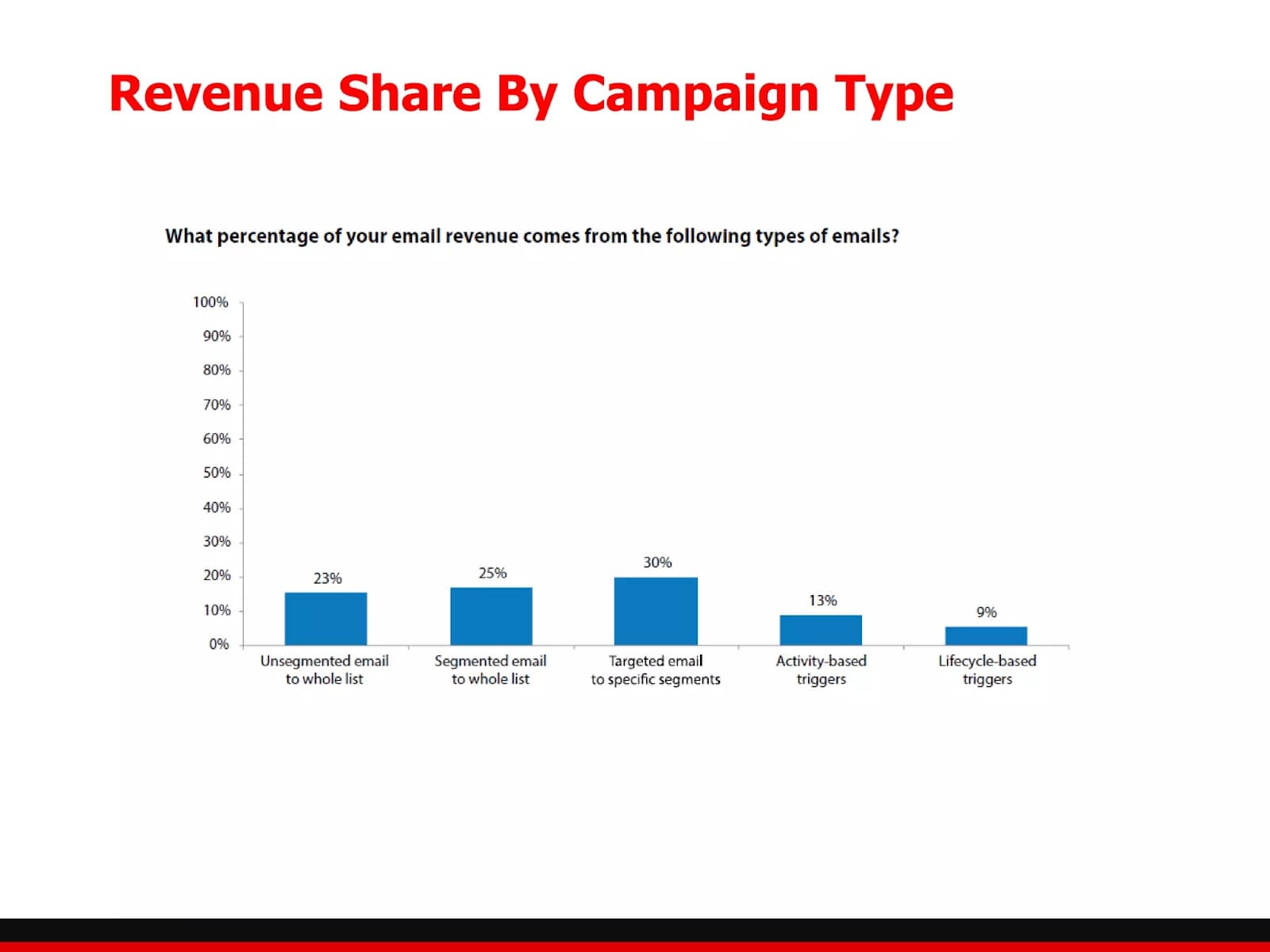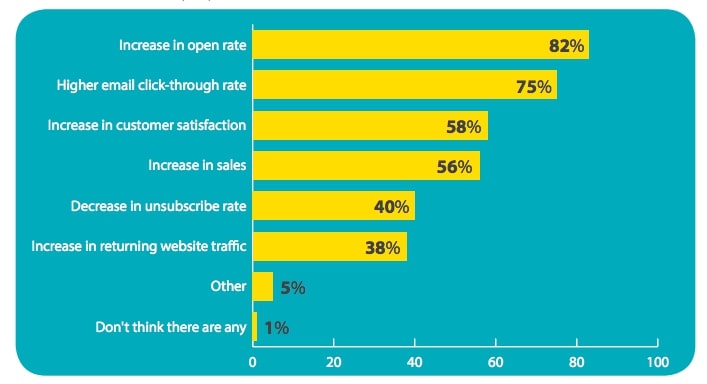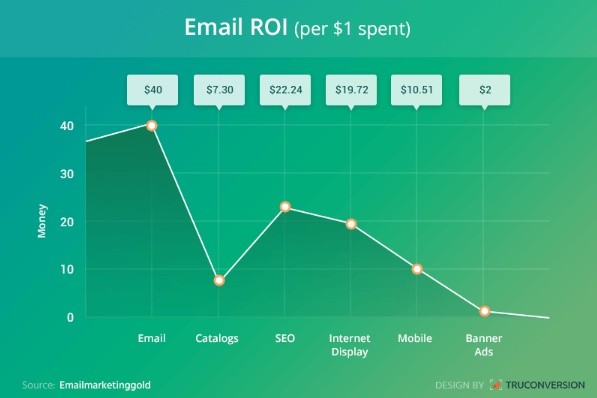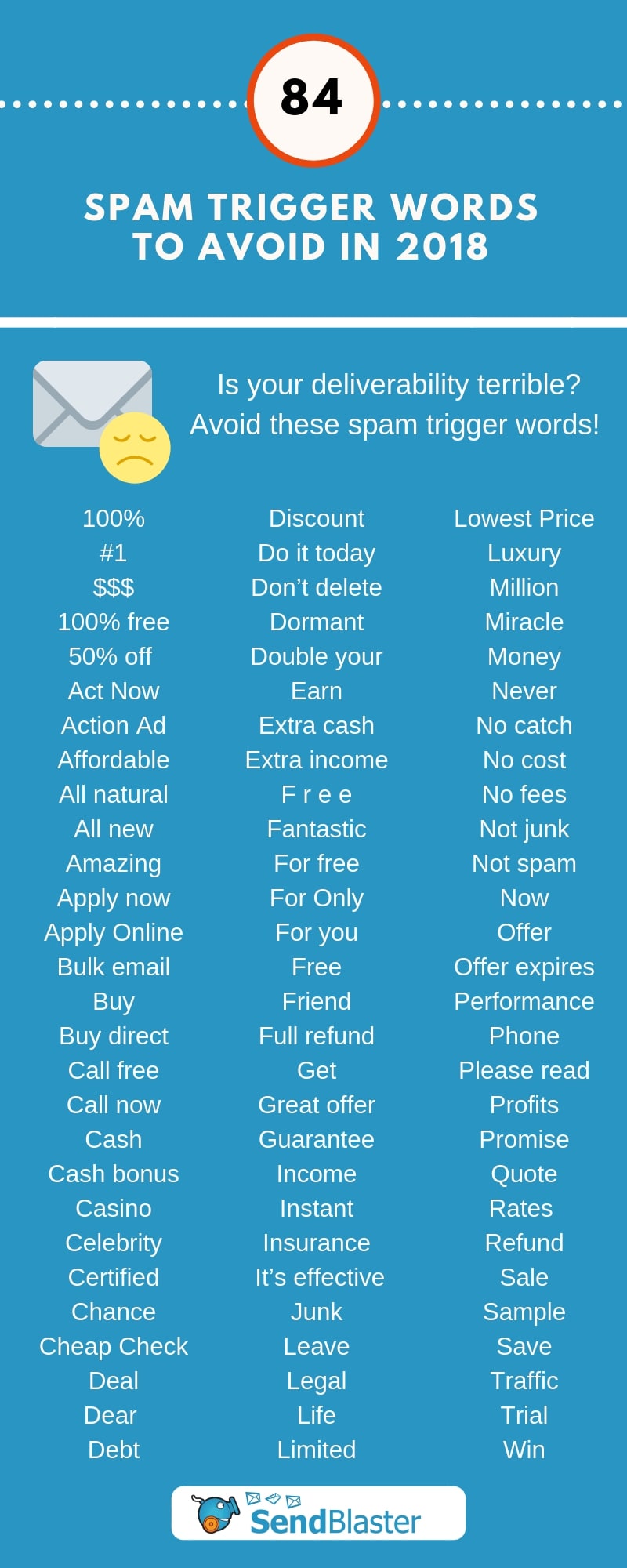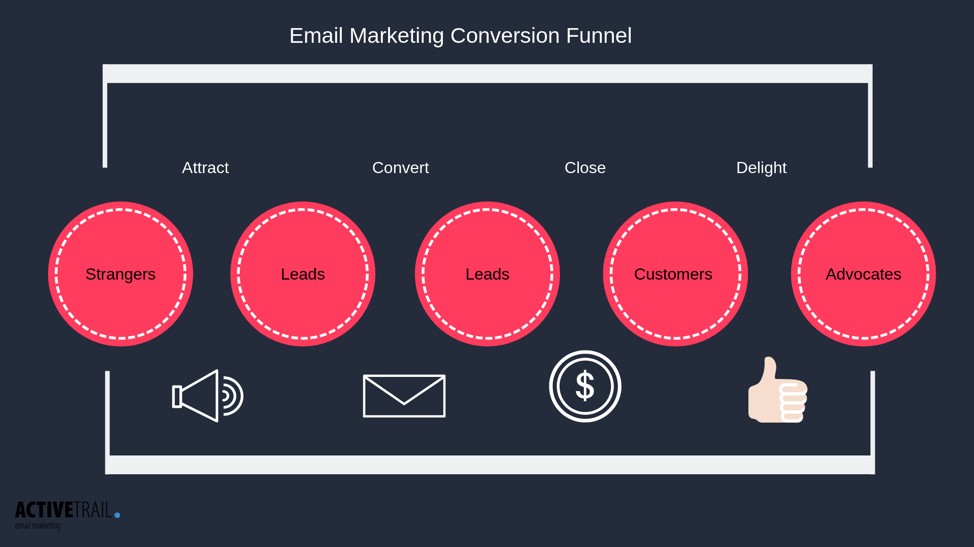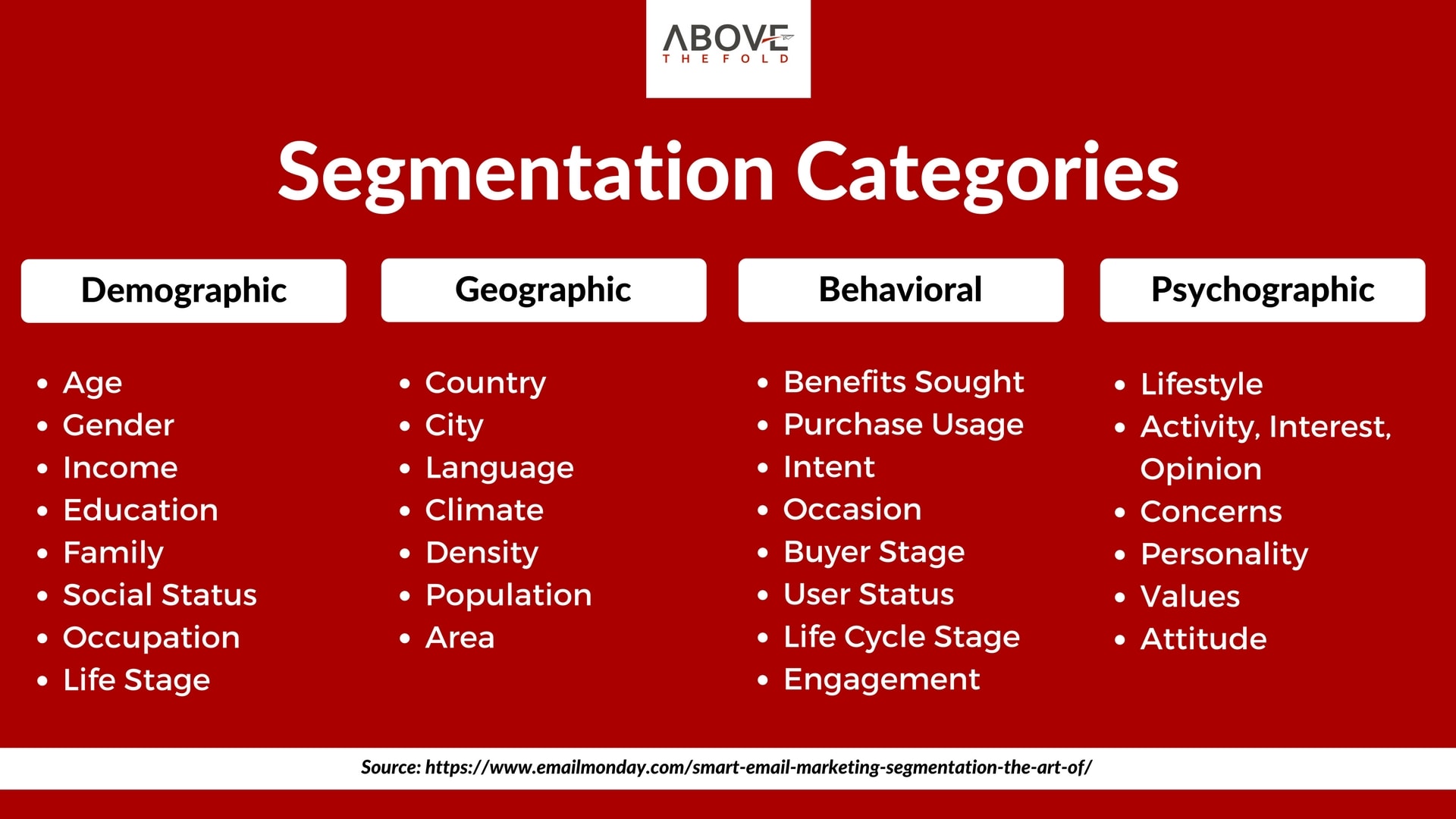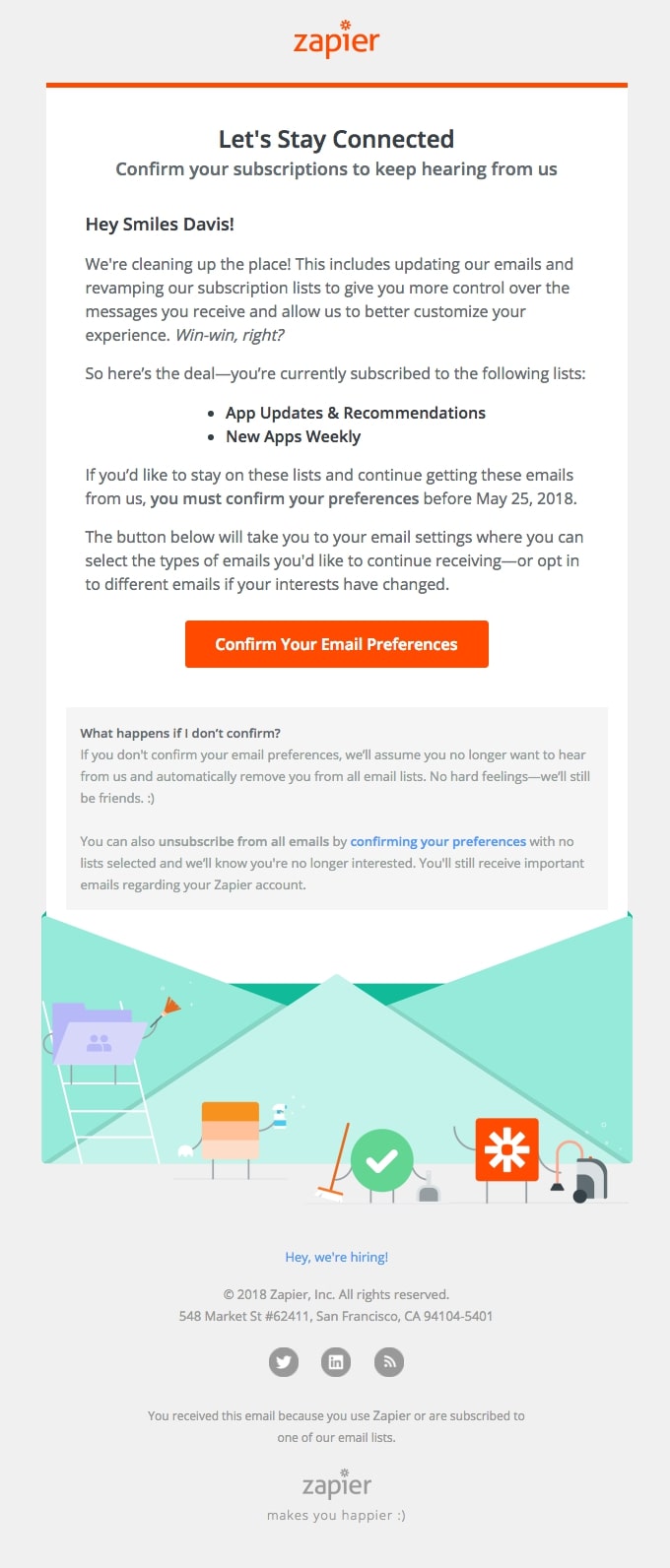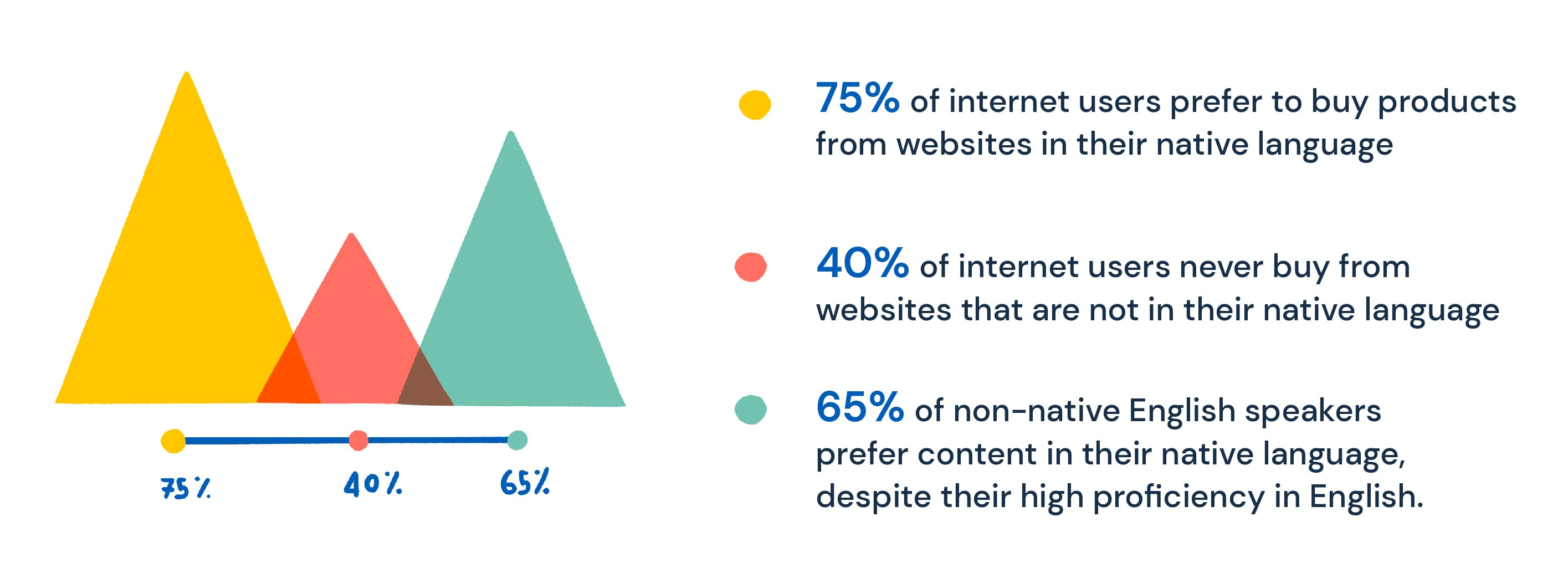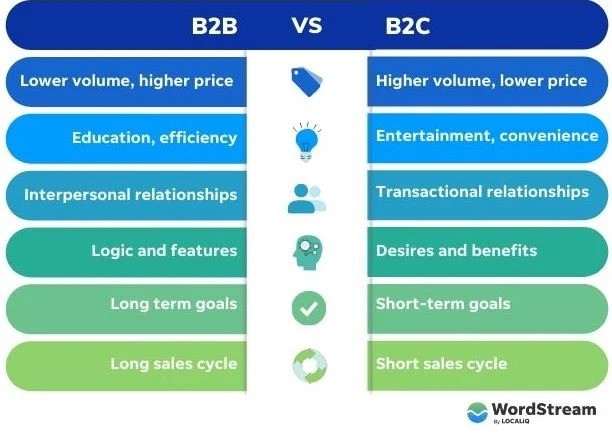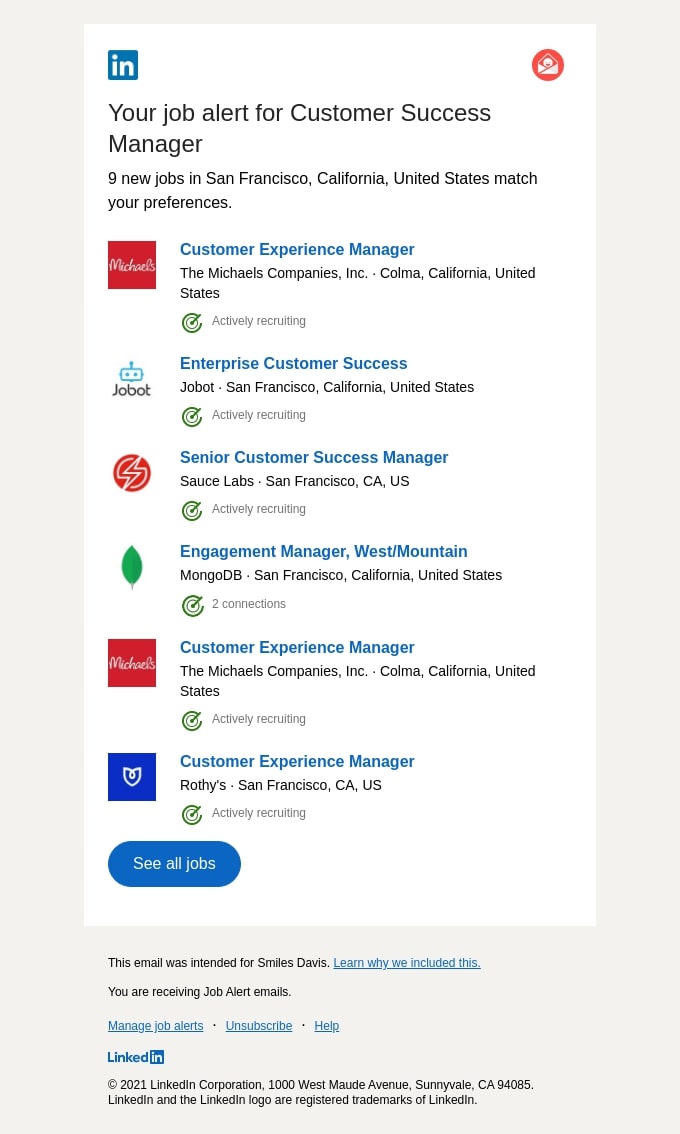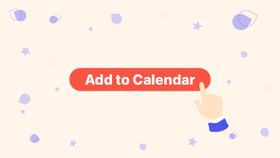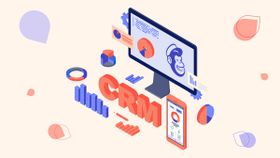What is Email Segmentation + 13 Fresh Ideas
Ever wonder what is email segmentation, and how can you implement it into your email marketing strategy? Don't miss these benefits, how-tos, and examples.
Updated November 6, 2024.

Online communication is easy. You type or upload something, hit Publish or Send, and then it can reach thousands, if not millions of people at the same time.
Email marketing makes this easier than ever, both in functionality and your control over when your messages reach your audience.
But this can also result in online communication that's dry, impersonal, and even irrelevant for potential or current customers.
Say you have a store that sells socks, linens, and towels. Not all of your followers are interested in all three categories. Someone may be interested in the socks you sell, but aren't interested in your store's bed linens. Add impersonal, dry communication on top of everything, and it's easy to understand why your conversion rates aren't exploding or you're not cultivating customer loyalty.
This is where email segmentation can save the day. It lets you tailor marketing emails to each person on your list based on their behavior and interests. It's not a fancy trick. It's a best practice that can bring you more revenue, no matter what type of business you run.
(Source)
Want to make the most out of it? Keep reading and find out more.
What is email segmentation?
Email segmentation is a digital marketing practice where you divide subscriber lists into separate segments for more targeted and effective emails. Email marketers do this by grouping subscribers with similar attributes, characteristics, or behaviors into segments so that they can send tailored and personalized messages to each segment.
The difference between email segmentation & personalization
Email segmentation and email personalization are similar concepts, so it's no wonder they get easily confused. The main difference is that email segmentation refers to the process of dividing subscribers into groups based on shared characteristics, while email personalization involves tailoring the content and messaging within each email to match the specific needs and interests of individual subscribers.
9 advantages of email segmentation
Although segmenting your email list can be time-consuming (especially if you haven't been doing it since the beginning), it's extremely beneficial. Some of the most notable advantages of email segmentation include:
Improved open rates
Segmented emails tend to have better open rates because they are tailored to the recipient's interests or behaviors. Rather just another generic marketing communication in the recipient's overflowing inbox. Instead, these emails contain information that's relevant and valuable to the recipient.
As a result, recipients are more likely to open and engage with these emails, leading to improved open rates. This underlines the importance of understanding your target audience's preferences and segmenting your email list accordingly.
(Source)
Higher click-through rates
Segmented emails can help raise click-through rates because they contain content that is tailored to the recipient's interests and needs. When a subscriber receives an email that resonates with their particular lifestyle, preferences, or problems, they are more likely to be intrigued and click on the links embedded within the email.
This is especially true if the email offers a solution or benefit that matches their unique circumstances. Therefore, email segmentation leads to more effective targeting and engagement, ultimately resulting in higher click-through rates. This reinforces the importance of segmenting your email list based on various factors such as subscriber behavior, interests, or demographics.
Boosted conversion rates
Email segmentation also can boost conversion rates significantly. A segmented email list enables you to craft personalized messages that cater to the specific interests and needs of your subscribers. It fosters a deeper connection with your brand, ultimately leading to increased conversions, a critical metric for the success of your email marketing efforts.
When recipients receive an email that aligns with their preferences and offers them real value, they are more likely to take the desired action, be it purchasing a product, signing up for a webinar, or downloading a resource.
Higher return on investment
The higher return on investment (ROI) seen with email segmentation stems from the increase in engagement rates and conversions. When you send targeted emails to segmented groups – tailoring content to their specific needs and interests – you increase the likelihood of them engaging with your content and eventually converting.
This leads to more sales, sign-ups, or whatever conversion metric you use, increasing the overall ROI of your email marketing campaign. Moreover, segmentation can help decrease costs by reducing the number of irrelevant emails sent, as too many irrelevant emails can lead to a higher unsubscribe rate. Providing content that offers value to your subscribers keeps them engaged and loyal to your brand, maximizing your marketing investment.
(Source)
Lower unsubscribe rate
Segmented emails are far less likely to lead to unsubscribes. When you divide your email list into segments, you're ensuring that the content you send is relevant and valuable to the recipients. This decreases the chance of recipients unsubscribing due to a lack of interest or feeling overwhelmed by irrelevant content.
Remember, people typically unsubscribe from email lists when they feel that the content is no longer useful or relevant to them. By sending content that directly appeals to their needs and interests, you can maintain a healthy subscriber list and significantly reduce the unsubscribe rate.
Avoiding spam filters
One critical benefit of email segmentation is its potential to help marketers avoid spam filters. Spam filters are designed to weed out irrelevant and unsolicited content. When you send the same general email to your entire list, it increases the likelihood that some recipients will mark your emails as spam. This is either because the content doesn't resonate with them, or they feel overwhelmed by the frequency of irrelevant emails.
However, when you segment your email list and send tailored content, your emails are more likely to land in the inbox and less likely to be reported as spam. When recipients generally associate your emails with relevant and valuable content, they'll be less likely to mark your emails as spam. Therefore, email segmentation is a powerful tool to ensure email deliverability and allow you to reap the full benefits of your email marketing efforts.
(Source)
Creating a more human experience
Email segmentation creates a more human experience because it allows for personalized communication. When recipients feel that content is tailored to their interests and needs, they perceive it as more personal and meaningful rather than generic. It evokes a sense of being understood and valued by the brand, thereby building a deeper, more human connection.
In essence, segmentation enables brands to communicate effectively with their audience on a more personal level, fostering a stronger bond and enhancing customer loyalty. This highly personalized approach makes the recipient feel like they are interacting with a human, rather than a faceless brand, which ultimately enhances the overall user experience.
Adjusting to different stages of the customer cycle
Email segmentation is especially effective in adjusting to the different stages of the customer cycle. It allows you to tailor messaging based on the customer's current stage in their relationship with your brand.
For example, a new subscriber may benefit from introductory content explaining the value of your brand. Meanwhile, a long-time customer might be more interested in advanced usage tips or new product announcements.
When you segment your email list based on where customers are in their lifecycle, you can ensure they receive content that is timely, relevant, and valuable at their specific stage. This makes your communication efforts more effective and can significantly enhance your customer relationship at every touchpoint, leading to increased brand loyalty and higher conversion rates.
(Source)
Better deliverability
Better deliverability is another profound advantage of email segmentation. Since segmented emails are specifically designed based on the recipient's preferences and behavior, they are less likely to be ignored or deleted. This translates to a higher deliverability rate.
When an email is opened and interacted with, email service providers (ESPs) perceive such emails as relevant and high-quality, improving the sender's reputation score. A better reputation score subsequently improves the deliverability of future emails. Thus, email segmentation indirectly contributes to a higher email deliverability rate, ensuring your messages reach the intended recipients' inboxes rather than their spam folders.
Top 12 ways to segment your email list (for the best results)
There are many ways to segment your email list, and email marketing pros will apply multiple segmentation filters to ensure detailed targeting. Here are the 12 most effective ways to segment your email list for better results:
Demographic segmentation
Demographic segmentation involves dividing your email list based on demographic information, like
- Age
- Gender
- Income level
- Education
- Marital status
- Occupation
This method is effective because these factors significantly influence consumer behavior and preferences. By leveraging demographic segmentation, you can tailor your email content and offers to suit the specific needs and interests of each demographic group, leading to higher engagement and conversion rates.
For instance, a beauty brand could segment its email list based on gender. Its marketing team could send emails about its latest lipstick range to female subscribers, while male subscribers could receive emails about the new line of men's grooming products. This helps make sure every subscriber receives content that is relevant and appealing to them, thereby enhancing engagement and boosting conversions.
Geographic segmentation
Geographic segmentation involves dividing your email list based on the geographic location of your subscribers. This can be as broad as the country they live in, or as specific as the city or even the neighborhood.
Geographic segmentation is useful for sending targeted emails based on factors such as the local weather, cultural events, or regional preferences, which can significantly improve the relevancy and engagement of your emails.
For example, a clothing retailer could use geographic segmentation to send targeted emails based on the current season in a subscriber's location. Subscribers living in colder climates might receive an email promoting the latest winter collection, while subscribers in warmer areas could receive an email about beachwear. Similarly, a local business could send emails about a local event or sale only to subscribers living in the same city or neighborhood, ensuring that every subscriber receives relevant messages and content.
(Source)
Email engagement segmentation
Email engagement segmentation divides your email list based on how subscribers interact with your emails. Variables such as open rates, click-through rates, response rates, and the frequency of interactions are considered in this type of segmentation. Analyzing these metrics to understand your subscribers' engagement level, and tailor your email communication to enhance engagement.
For instance, subscribers with high open but low click-through rates might indicate that your subject lines are effective in prompting opens, but your email content or call-to-action may not be compelling enough to induce clicks. You'll want to experiment with different content or call-to-action to enhance engagement.
On the other hand, subscribers with consistently low open rates may not be finding your emails relevant. You could re-engage such users with a targeted reactivation campaign or consider removing them from your list to maintain a healthy email deliverability rate.
Marketing preferences segmentation
Marketing preferences segmentation involves categorizing your email list based on the type of content and communication each subscriber prefers. This not only ensures that your subscribers receive information that is most relevant to them but also helps in maintaining a positive relationship with them by respecting their communication preferences.
For example, some subscribers might be interested in receiving promotional content about your latest products or services, while others might prefer educational content that provides value, such as blog posts or guides.
Segment your email marketing list based on these preferences to ensure that each subscriber receives the type of content they ask for and want in their inboxes – whether that's educational content, informative, product-driven, or just system notices. By catering to these specific preferences, you can increase the relevance and value of your communication, leading to better customer engagement and loyalty.
Behavioral segmentation
Behavioral segmentation involves categorizing your email list based on customer behavior, including their past interactions with your brand, purchase history, product usage, website activity, and more. This nuanced form of segmentation allows you to deliver highly personalized and relevant content, further improving engagement and conversion rates.
For instance, an online bookstore might use behavioral segmentation to send personalized book recommendations based on a subscriber's previous purchases and browsing history. If a subscriber frequently browses and buys mystery novels, they could receive emails promoting new mystery book arrivals, or a special offer on a popular mystery series. This method increases the relevancy of the emails and leverages the subscriber's established interest, thereby increasing the chances of conversion.
Similarly, you could segment your list based on how often someone buys from you, the price range of the products they choose, and so on. Some email marketing platforms will automatically connect to your store to pick up on any such behavioral cues and help you segment your lists accordingly.
Personal interests segmentation
Personal interests segmentation is a strategy where your email list is divided based on your subscribers' unique interests and hobbies. This allows you to tailor your content and offers to match the individual interests of your subscribers, thereby enhancing the personalization and relevancy of your emails.
Consider a sports store with a diverse range of products catering to different sports activities. Its customer base might include potential subscribers who are interested in different sports like soccer, basketball, or tennis.
Segmented email campaigns based on these personal interests allow for sending targeted emails to each group. Soccer enthusiasts can get emails about the latest name-brand cleats, and tennis lovers get emails about new racket models. This way, every subscriber receives content that aligns with their personal interests, leading to a better user experience and increased chances of a sale.
(Source)
Source-driven segmentation
You can also segment your contact lists according to where they came from in the first place. This type of segmentation involves categorizing subscribers based on the channel or platform through which they subscribed, such as your website, social media platforms, search ads, or events.
This type of segmentation helps you understand where your most engaged and valuable subscribers are coming from so that you can focus your efforts on acquiring more subscribers from those channels. It also allows you to tailor your communication and offers based on the specific interests or behaviors of subscribers from a particular source, further enhancing engagement and conversion rates.
For example: if you notice that your website visitors are highly engaged with your content but have low conversion rates, you could create targeted email campaigns offering them a special deal or discount to encourage them to make a purchase. Similarly, subscribers who signed up via ads can receive promotional emails with exclusive offers, incentivizing them to fill up their cart and buy.
eRFM segmentation
eRFM segmentation stands for "email Recency, Frequency, Monetary" segmentation, and is a refined version of traditional RFM segmentation. eRFM uses email data to create different categories of users in your database based on how recently they've interacted with your emails, how frequently they open or click-through, and the monetary value of their purchases. This type of segmentation allows you to identify high-value subscribers and target them with personalized offers and promotions, ultimately leading to increased engagement and revenue.
So for an e-commerce business, say a subscriber has recently made a purchase, and frequently opens and clicks on emails. They might have a high monetary value, classifying them as a VIP customer. They could receive exclusive promotions, early access to sales, or free shipping on every order.
This makes the subscriber feel valued and incentivizes them to continue engaging with your brand. On the other hand, subscribers who have not interacted with your emails for a while can receive targeted emails to re-engage them, such as special discounts or abandoned cart emails. This can help bring back inactive subscribers and improve overall engagement with your emails.
(Source)
Email domain-driven segmentation
Email domain-driven segmentation is a method of categorizing your subscribers based on their email service provider. This may seem trivial, but it can offer you valuable insights into your subscribers. For instance, users of different email providers may have different demographics, or they might interact with emails in different ways due to the unique interfaces and functionalities of their respective email platforms.
Say you notice that a majority of your subscribers use Gmail and open most of their emails on mobile devices. You might adjust your email design to be more mobile-friendly.
If your data shows that Outlook users have a lower open rate compared to others, you might look into possible deliverability issues or compatibility problems between your emails and the Outlook platform. This email segmentation strategy allows you to optimize your email campaigns for each group and enhance your overall email marketing effectiveness.
Subscription recency
Subscription recency segmentation refers to the strategy of segmenting email subscribers based on the recency of their subscriptions. This method allows you to tailor your email content to your audience's familiarity and engagement levels. New subscribers might need more information about your brand and products, while older ones could benefit from loyalty rewards or re-engagement strategies.
For instance, if a user has recently subscribed to your newsletter, they may benefit from a welcome email series that introduces them to your brand, showcases your top-selling products, and offers them a special discount on their first purchase. This can help build a positive relationship with the new subscriber and encourage an initial purchase. On the other hand, if a user has been subscribed for a long time but has not engaged recently, send a re-engagement email offering a special discount or showcasing new products that may interest them. This can rekindle their interest and increase their chances of purchasing.
Language-driven segmentation
Language-driven segmentation involves categorizing your email subscribers based on their preferred language or the language settings of their device. This segmentation strategy is vital for businesses operating in multilingual markets or aiming to offer more personalized and relevant emails to their diverse subscriber base.
For instance, if your e-commerce store caters to customers worldwide, you may have subscribers who prefer English, while others might be more comfortable with Spanish or French. Segment your list according to language preferences, and you can send targeted emails in each user's native language, increasing the likelihood of engagement.
(Source)
Industry-driven segmentation
If you target multiple industries and have subscribers from different sectors, industry-driven segmentation can help you craft more relevant and personalized emails for each group. This type of segmentation takes into account the unique needs and interests of subscribers in various industries, allowing you to tailor your content and offers accordingly.
For example, if your business provides software solutions to both healthcare and finance companies, you could segment subscribers based on these industries. You could then send targeted emails to healthcare subscribers highlighting the benefits of your software for their industry, while also sending tailored emails to finance subscribers with relevant case studies and testimonials from other finance companies who have used your solution successfully. This can help increase engagement and conversions within each specific group.
How to start segmenting your emails
Email segmentation can be a really powerful tool, but you need to do it strategically and methodically if you don't want to turn your email list into an entangled chaos. Here are the basic steps to follow if you want to start segmenting your emails:
Define what data you’ll use
The first step in email segmentation is to determine the data you'll utilize. Depending on your business type and goals, This could include demographic information, purchase history, engagement rate, email domain, subscription recency, language preference, or industry. The data chosen should align with your overall marketing strategy and help you understand your subscribers' behavior and preferences.
Collect the data
After identifying the data, you need to collect and analyze it. Using email marketing analytics tools, email marketing tools, signup forms, or customer surveys, group subscribers according to your insights. For example, you could divide them into groups based on their engagement levels or industries. This allows you to tailor your content and offers to each group, improving engagement and conversions.
Experiment
After you've organized your subscribers into relevant groups based on the data collected, it's time to experiment with these segments. This could involve A/B testing different types of content, offers, or subject lines to see what resonates best with each segment. For example, you might send a promotional offer to one segment, and a content-heavy newsletter to another, and then compare the engagement rates.
The goal of this experimentation is to help you tailor your email marketing strategy to meet the unique needs and preferences of each segment effectively. Remember to consistently monitor and evaluate the results of your experiments to adjust your strategy accordingly. This process of experimentation, evaluation, and adaptation ensures your email marketing efforts are effective and relevant to your audience.
(Source)
Measure and adjust
Email segmentation enhances the relevance and personalization of your email marketing campaigns. It begins with identifying the data that aligns with your marketing strategy, followed by collecting and analyzing that data on an ongoing basis.
Next, organize your subscribers into groups based on shared characteristics, such as demographics, purchase history, engagement rates, the domain of their emails, subscription recency, language preferences, or industry. Once you've grouped your subscribers, A/B test with different content and offers for each segment to find what works best for each group.
The final step: measure the results of your experiments and adjust your strategy based on those findings. This iterative process ensures your email marketing remains effective and attuned to your audience's needs and preferences.
Top 13 email segmentation ideas
The main point of segmenting your email list is to make your audience more connected and/or engaged with your brand. Here are some segmentation ideas that will get you there:
Welcome and onboarding emails
Welcome emails are a valuable tool for onboarding new subscribers to your email list and setting the tone for your future communications. They typically include a warm greeting, an overview of what the subscriber can expect in terms of content and frequency, and possibly an incentive, such as an exclusive discount code, to encourage immediate engagement. These emails help build a positive relationship with new subscribers and lay the foundation for their brand experience.
In contrast, onboarding emails are introductory emails sent to new customers who have made their first purchase or signed up for your services. These emails generally acknowledge and appreciate the customer's choice to select your brand, offer useful information about their purchase or service, and suggest next steps to further engage the new customer.
Both onboarding and welcome emails are essential in nurturing the customer journey and fostering loyalty towards your brand.
(Source)
Exclusive deals and special offers
If you have the data, you can always segment your list to send exclusive deals and special offers to specific categories of people. For instance, you might offer a discount to members of your email list likely to celebrate a holiday (like Mother's Day emails or Father's Day campaigns). You can even leverage location data to send targeted offers based on the subscriber's geographical area, indicating they're more likely to celebrate a holiday or not.
Separate lists for B2B and B2C
If your business sells to both B2B and B2C, you might need to create different communications for each category. In this case, email list segmentation can help you avoid sending irrelevant content to the wrong audience.
For example, your B2B customers might be interested in different product features or industry news compared to your B2C customers. By segmenting your email list, you can tailor your messaging and offers accordingly and increase engagement with both groups.
Geographic location
Geographic segmentation is an effective way to personalize emails based on cultural, social, and economic differences among your subscribers. For example, you might offer different promotions or product recommendations to subscribers in different regions based on their specific interests or values. This can also be useful for localizing content and offers to match the needs of your audience in a particular region.
Leverage contacts with high open rates
Having subscribers with consistently high email open rates presents a valuable opportunity. These individuals are highly interested in your content and are more likely to engage with your brand. You can create a segment for these subscribers to deliver more targeted content. Delivering personalized content that aligns with their interests and behavior may further enhance their engagement and convert them into loyal customers.
Moreover, these high-engagement subscribers can serve as a valuable source of insights. Analyze their behavior, preferences, and interactions with your emails to understand what resonates most with your audience. Then you can apply these insights to your broader email marketing strategy, potentially improving open rates and engagement across all email segments.
Re-engage inactive users
A segment of your email list may include subscribers who have been inactive or less responsive to your emails over a certain period. These may be individuals who have not opened your emails for several months or haven't clicked on any links in your emails. Re-engaging these contacts through targeted campaigns can help revive their interest in your brand and potentially convert them into active subscribers.
Such campaigns should be personalized to acknowledge the subscriber's recent inactivity and offer an incentive that encourages them to re-engage with your brand. For instance, you could offer a special discount, a free e-book, or exclusive access to new content or products. This strategy reminds inactive subscribers of your brand's value and motivates them to become active participants in your email community once again.
Show you value loyalty
Loyal customers are the backbone of any successful business and should be recognized and rewarded. Segmenting your email list based on customer loyalty can help you create unique and personalized experiences for your most dedicated subscribers. You can offer perks such as early access to new products, exclusive deals, or loyalty discounts to show your appreciation and strengthen their connection to your brand.
Moreover, understanding your loyal customers' preferences and behaviors can give you valuable insights to improve your overall marketing strategy. Use this information to create content and offers that resonate with similar audience segments. Loyalty segmentation strengthens the bond with your current loyal customers and can also help cultivate loyalty among new and potential customers.
(Source)
Send cart abandonment emails
Cart abandonment emails are an effective strategy for re-engaging customers who added items to their shopping cart but didn't complete the purchase. These automated emails serve as a reminder of the products left in the cart, providing another opportunity for conversion. They may also include personalized incentives, such as a limited-time discount or free shipping, to encourage completion of the purchase.
This type of email has a dual purpose:
First, it helps businesses recover potentially lost sales.
Second, it offers valuable insights into why customers might be abandoning their carts, such as high shipping costs, complex checkout processes, or lack of payment options.
Armed with this knowledge, businesses can address these issues to improve the overall customer experience and reduce future cart abandonment rates.
Remind customers of re-fills and re-stocks
Email segmentation can also be used to remind customers about product refills or restocks. If your business deals with consumable goods, sending personalized reminders when a customer is likely to be low can prompt timely repurchases. Similarly, alerting customers who showed prior interest can trigger immediate purchases if an out-of-stock item is back.
This strategy not only enhances the customer experience by taking away the need for them to remember to reorder but also demonstrates your brand's commitment to their convenience. Moreover, restock alerts give the impression that the brand is considerate and customer-focused, which aids in building long-term customer relationships and loyalty.
Build nurture campaigns
Nurture emails aim to educate and build trust with subscribers and guide them through the customer journey. Segmenting your email list based on subscriber behavior and interests can help create personalized nurture campaigns that align with their specific needs. For example, new subscribers may receive a "welcome" series of emails that introduces them to your brand and products or services.
These email journeys can also target subscribers based on where they are in the sales funnel, sending relevant messages that address their specific needs and objections. Nurture campaigns can help build stronger relationships with your subscribers, nurturing them into loyal customers over time. By tailoring the content to each segment's interests and behaviors, you increase the chances of converting them into paying customers.
Automate emails according to job titles & roles in company
Sometimes, multiple people in the same company or department are subscribed to your email list. In this case, if you want to make your communication as targeted as possible, you can segment your list by roles in the company. For instance, you can create segments for executives, managers, or team members and tailor the content to their specific job responsibilities and interests.
This approach lets you send highly relevant and valuable information to each segment, increasing engagement and potential conversions. It also shows that your brand understands and caters to the needs of different levels within a company, building trust and credibility. Additionally, by targeting specific job roles, you can personalize the call-to-action to align with their decision-making power, making it more effective in driving conversions.
Build persona-driven campaigns
Persona-driven campaigns effectively segment your email list by grouping subscribers based on shared characteristics, behaviors, and motivations. These can range from demographic details to purchasing behavior or even the challenges and goals that they face. By creating detailed subscriber personas, you can tailor your email content to better resonate with different segments, increasing engagement and conversion rates.
For instance, if your business caters to both young professionals and retirees, these two groups will have different needs and interests. Therefore, creating a separate campaign for each segment will allow you to provide value in a way that most appeals to them. This makes your emails more relevant and shows your subscribers that you understand and value their individual needs.
Create separate campaigns for bargain and luxury shoppers
Email list segmentation can effectively distinguish bargain and luxury shoppers, catering to their unique needs and purchasing behavior. Bargain shoppers are typically interested in discounts, sales, and the best possible deals. Offer them special offers, coupons, and cost-saving opportunities in your email campaigns. On the other hand, luxury shoppers are more focused on the products' quality, exclusivity, and premium nature, and are hence less sensitive to price, so overly-emphasizing discounts in your email copy might cheapen your image.
The campaigns for luxury shoppers should emphasize the high-end aspects, unique features, and superiority of the product or service. This could include exclusive previews of new product lines, invitations to VIP events, or information about limited edition items. By understanding and catering to these different shopping behaviors through targeted email campaigns, businesses can effectively engage both types of customers and increase conversions accordingly.
Pro tip: Want to learn more about email marketing and how to use it well? We have compiled a list of 21 books about email marketing to help you nail your communications and drive more engagement and revenue from your emails.
Email segmentation: the beginning of a beautiful friendship
Email segmentation can be likened to a dinner party host planning a menu. The host may have a diverse group of guests, with differing dietary preferences and restrictions – some may be vegetarians, some may be allergic to certain foods, and others may simply dislike certain types of cuisine.
The host could prepare one type of food and call it an evening. Whoever doesn't like it, or cannot have it, can eat some crackers and go home. In practice, that would probably mean a lot of disappointed and hungry guests – not ideal for creating a pleasant and memorable experience. Similarly, sending the same generic email to your entire subscriber list may result in low engagement rates and missed opportunities for conversion.
In contrast, by segmenting your email list and tailoring the content to each group's interests and preferences, you can create a more personalized and enjoyable experience. You can create messages different audience segments actually get and resonate with, CTAs they want to click on, and offers they want to take advantage of. This leads to a more positive perception of your brand and can ultimately drive conversions and customer loyalty.
Need help with your email marketing efforts? Contact Mayple and allow us to match you with the best email marketing consultant for your business!
